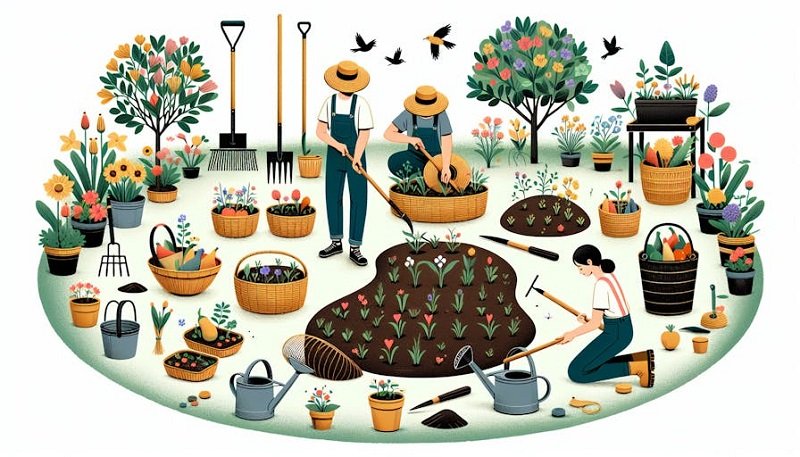Growing Joy: Embracing Gardening As A Hobby

Exploring Nature-Based Hobbies
Getting out in the fresh air offers a kind of happiness and perks you won’t find in a room filled with screens. As an adventure lover who thrives in nature, I stumbled upon gardening, and let me tell you, it’s a gem of a hobby!
Introduction to Nature-Based Hobbies
We’re spoiled for choice when it comes to hobbies that get us cuddling up to nature—think birdwatching or ogling at stars. Each of these invites us into the arms of the great outdoors. Garden therapy, as I like to call it, has become my preferred escape. Growing and taking care of plants isn’t just a task; it’s a soul-hug. Plus, I get to watch the wonders of nature come alive right in my backyard.
| Outdoor Hobby | What’s It About? |
|---|---|
| Birdwatching | Scoping out and naming different birds. |
| Stargazing | Peeping at stars and planets. |
| Hiking | Roaming trails and soaking up views. |
| Gardening | Raising and pampering plants. |
Perks of Chatting with Nature
Messing about with nature-centric hobbies isn’t just fun—it’s got oodles of goodness for your body and mind. Gardening, for instance, is a grand mix of moving around, making new pals, and catching some rays. A deep dive into PubMed Central backs this up, noting that getting dirty in the garden can boost what you eat, fine-tune your fingers, and chase away that lonely feeling. Here’s how gardening has jazzed up my life:
- Boosted Physical Health: Shoveling soil, sticking plants in the ground, and watering are not just chores—they’re a workout that builds muscle, supports balance, and spruces up your nimble fingers. Green thumbs unite in backing the green scene for its health boons (PubMed Central).
- Mindful Happy Place: Nature has a chill-factor that’s hard to beat, slashing stress levels like nobody’s business. Getting into the groove of gardening is like jumping into a meditation practice, helping you dodge daily chaos. It’s a budget-friendly mental escape, perfect for keeping both body and brain ticking along nicely (PubMed Central).
- Neighborly Vibes: Community garden plots are a no-judgment zone where everyone can dig in together, making pals and building a village spirit (Sabina Gardens). In these spaces, swapping tips and sharing love for the land is the norm.
- Living Well: Harvesting your own veggies? That’s living the high life—eating fresh, clean goodies straight off the vine or branch. Community gardens help smooth out food wrinkles in neighborhoods too, getting everyone a slice of the organic pie.
For those itching to dive more into nature, I’ve whipped up some outdoor hobby ideas just for you. Whether you’re a trail blazer or prefer the zen garden life, nature connection offers massive joy and a ton of feel-good vibes.
Ready to get your hands dirty? Check out our easy-peasy starter guide on growing bell peppers and other garden treats. Let’s get growing!
Easy-to-Grow Fruits and Veggies
Kicking off my adventures in gardening as a hobby, I quickly realized that starting with some no-fuss fruits and veggies was where it was at. Here are a few of my all-time favorites that have turned my backyard into a tiny but mighty farm.
Growing Bell Peppers
Ah, bell peppers. These colorful nuggets are like little jewels in the garden. They show off in colors like red, orange, yellow, purple, and sometimes even a moody chocolate brown. Watching them change colors is pretty cool, though I found if you pick ’em too early, the colors will be there, but that sweet flavor might not catch up (Gardentech).
| Bell Pepper Stage | Characteristics |
|---|---|
| Early Pick | Colors, less sweet |
| Mature | Full color, sweeter |
Cultivating Cabbage
My cabbage patch wasn’t exactly the easiest start. Since cabbage loves chillier weather, starting from seed is a bit of a tightrope walk with summer wanting to crash the party. Planting these guys in mid to late summer, however, was my golden ticket to some good eats come fall. Cabbage feels right at home in cooler temps, making it a rock-solid member of my veggie crew.
Planting Strawberries
Strawberries are a sweet deal in the garden. As perennials, they make a comeback every year, which means less fussing over them. Plus, many kinds shoot out “runners,” sprouting baby plants to grow my berry empire, no extra cost.
Homegrown Tomatoes
No garden’s complete without a handful of tomato plants. Big or little, these red gems are pretty chill about where they grow, whether in big pots or right in the ground. Using plant cages has been my lifesaver, keeping them upright and easy to dig into when they’re ripe and ready. Nothing beats the taste of a tomato straight from the vine (Gardentech).
| Tomato Type | Growing Style | Gear Needed |
|---|---|---|
| Big Tomatoes | Big containers, plots | Plant cages |
| Small Tomatoes | Big containers, plots | Plant cages |
Zucchini and Squash Seeds
Zucchini and squash are kinda like the layup of the garden world. Just toss the seeds in the ground right at the end of spring and let the magic happen. For squash with thick skin, I let them hang out till winter. These plants just keep coming, and they’re a fun twist on my usual garden mix.
And if you’re itching for more ways to blend with nature, swing by our reads on birdwatching as a hobby and stargazing as a hobby.
Community Gardens
Community gardens are like little green gems in our concrete jungles, and they’ve really caught on in urban life, bringing all sorts of good vibes to city folks. Digging in the dirt isn’t just about making you happy—it’s a way to boost the whole community.
Social, Educational, and Cultural Objectives
These gardens create a buzz of social, educational, and cultural action. They turn strangers into neighbors, where everyone teams up to spread their gardening wisdom, grow fresh grub, and bond over shared love of nurturing plants.
These green patches also help folks revisit old-school practices like composting and recycling. They’re kinda like pop-up classroom, teaching practical skills for living sustainably. If you want to know how to get even more in tune with Mother Nature, check out our piece on outdoor adventure hobbies.
Health Benefits of Community Gardens
Getting your hands dirty in a community plot means you’re likely munching on some fresh, organic goodies you grew yourself. This is a game-changer for folks in cities who can’t easily grab healthy food (Sabina Gardens).
Gardening is more than just planting seeds; it’s a workout! It helps keep you fit and kicks stress to the curb, boosting your mood. It’s the full package deal of well-being, which you can learn more about in our article on gardening as a hobby.
Economic Value of Green Spaces
You’d be surprised how community gardens can make nearby homes pricier. Studies show a green space less than the length of a football field away can up house prices by 1.9% (Sabina Gardens).
| Benefit | Percentage Increase in Home Value |
|---|---|
| Proximity to Green Space (< 100m) | 1.9% |
Houses near these leafy spots are hot property, turning into must-haves in any neighborhood.
Learning Opportunities and Inclusivity
Community gardens are like the ultimate learning space where anyone and everyone can pick up nifty tricks like composting and organic farming. They bring people together, bridging the divides between different walks of life.
No matter who you are—what age, class, or background—these gardens welcome everyone. They’re spaces for mingling and learning, offering solutions for those with food needs. When it comes to making friends and learning, you can’t beat a community garden.
If you’re looking for more ways to enjoy nature beyond gardening, check out our suggestions for birdwatching as a hobby and stargazing as a hobby.
Therapeutic Benefits of Gardening
Oh boy, when I first picked up gardening, I had no idea I was stepping into a treasure trove of good vibes. It’s more than just playing in the dirt—it’s a whole universe of perks for your mind, body, and social life.
Gardening for Folks with Disabilities
You wouldn’t believe how helpful gardening can be for people with disabilities. A survey I came across said a cool 25% of folks with disabilities adore gardening. Plus, most of them—about two-thirds—are garden owners, and nearly 90% say their green spaces give their health a real boost.
Gardening helps improve strength, balance, and those fine motor skills. Doctors even suggest spending time in parks and green spaces to help deal with various medical challenges.
| Survey Data | Percentage (%) |
|---|---|
| Folks with disabilities into gardening | 25 |
| Garden owners in the mix | 66 |
| Beneficial garden access | 87 |
Projects like therapeutic horticulture in England have done wonders for those tackling mental health issues, learning challenges, or substance dependency.
Gardening and Mental Well-being
Gardening is like a tonic for mental health. It gets your body moving and your social life hopping, all while soaking up the sun. Picture this: growing a tiny seed into a booming plant. It’s calming, satisfying, and a great way to keep dementia at bay. Plus, it might just save some bucks on mental health services.
I found peace in growing plants. Watching them flourish brought me calmness and joy. For anyone wanting to branch out, you might also like checking out stargazing as a hobby or going all in for birdwatching.
Physical and Social Well-being
Digging and planting are more than chores. They’re secret paths to getting fit and making friends. The moving and grooving in the garden can boost your strength and balance. Socially, gardening can help shrink that loneliness bubble, hooking you up with fellow green-thumbed buddies.
| Activity | Benefits |
|---|---|
| Physical activity | Boosts strength, balance, dexterity |
| Social interaction | Keeps loneliness at bay |
| Being in nature | Cheers up your mental space |
I’ve had a blast swapping tips about plant care and bonding over the beauty of our gardens. For more outdoor escapades, consider outdoor hobby ideas like this one.
To wrap it up, gardening has been my go-to for a healthier mind and body. It’s given me more than I could’ve imagined, and I wholeheartedly recommend it to anyone looking for a hobby that gives back.
Vegetable Gardening Basics
Getting into vegetable gardening is like finding a treasure chest of both peace and grub. Seriously, there’s nothing quite like watching your dinner grow from scratch! So, whether you’re a newbie with a patch of dirt or someone looking to upgrade their tomato hustle, here’s your foolproof guide to kicking off this backyard adventure.
Site Selection and Soil Preparation
Picking the right spot is like finding a good sunbathing spot at the beach—absolutely essential for those veggies. Trust me, they need at least eight hours of that glorious sunshine (NC State Extension Publications). And if water loves to stick around like an uninvited guest, choose somewhere else—or you’ll have a soggy mess instead of a salad bar!
Soil Preparation Steps:
- Clear the Area: Kick out rocks and weeds like you’re prepping for a garden party.
- Test the Soil: You gotta know what you’re working with. Check pH and nutrients. Veggies love chillin’ in soil with a pH between 6.0 and 7.0.
- Improve the Soil: Get a compost party going or introduce well-rotted manure to beef it up.
Seed Selection and Planting
Making the right seed choices can mean the difference between a banquet and a bust.
Seed Selection Tips:
- Climate Suitability: A cactus wouldn’t thrive in Alaska, right? Tomatoes love it warm (Christine Covino Blog) so check what thrives in your backyard.
- Quality Seeds: Don’t just grab any packet that catches your eye. Go for quality—your taste buds will thank you!
Planting Steps:
- Plan Your Garden: Draw it out. Nope, stick men not required. Just know where everything’s going.
- Read Seed Packets: It’s like reading a recipe. Depth, spacing, the whole shebang—it’s all in there.
- Prepare Planting Holes: Stick to the seed packet’s guidance for a solid start.
- Water Plants: Give those seeds a good soak, they’ll need it to put down roots and settle in.
Maintenance and Harvesting Tips
Keeping those veggies happy means a bit of tender loving care.
Watering Tips:
- Frequency: Give thirsty young seedlings a drink every day or two. Older plants in summer, more often, like the extra watering an ice cream truck needs on a sunny day.
- Best Time: Early morning, my friend. It helps keep leaves from getting crispy in the sun.
Weeding and Mulching:
- Regular Weeding: Pull those pesky party crashers so your veggies get all the nutrients.
- Mulching: Keeps the ground nice and moist while keeping weeds at bay.
Fertilizing:
- Organic Options: Treat your soil to some compost or organic fertilizers—it’s like a gourmet meal for your plants.
Harvesting Tips:
- Check Ripeness: You wouldn’t eat a green tomato now, would ya? When they’re red and firm, it’s chow time (NC State Extension Publications)!
Maximizing Space and Production
Even if you’re working with a patch the size of a postage stamp, there’s room to grow.
Space Maximizing Tips:
- Vertical Gardening: Grow upwards! Cucumbers, peas, all the climbers love a good trellis.
- Succession Planting: As soon as something’s done, slap in the next batch. Keeps your crisper full year-round.
- Companion Planting: Team up plants like basil and tomatoes. They’re a dynamic duo, improving each other’s growth and taste.
Expand your garden horizons with our guides on birdwatching or stargazing. It’s a whole vibe being one with nature!
| Vegetable | Sunlight Requirements | Planting Season |
|---|---|---|
| Tomatoes | 8 hours | April – June |
| Bell Peppers | 8 hours | April – June |
| Strawberries | 6-8 hours | Spring or Fall |
| Zucchini | 6-8 hours | Late Spring |
| Cabbage | 6 hours | Early Spring or Late Summer |
Get your hands dirty and turn a simple garden into a bountiful source of fresh, homegrown goodness with a magical twist of daily life bliss.






